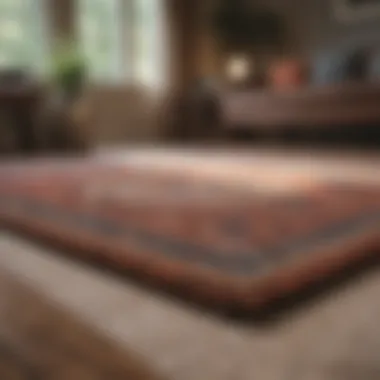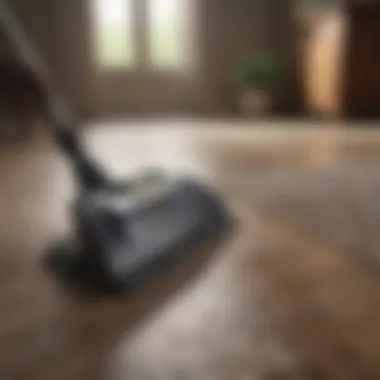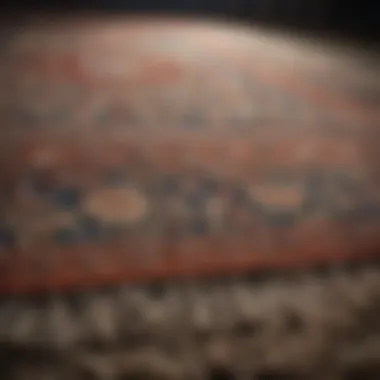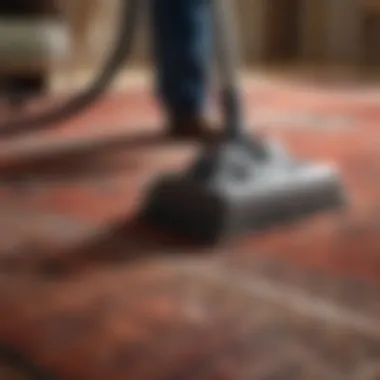A Comprehensive Guide to Cleaning Area Rugs


Intro
Cleaning area rugs is a meticulous yet essential task that homeowners often overlook. Area rugs serve not only as a decor element but also provide comfort and warmth to living spaces. Regular maintenance extends their longevity while preserving their aesthetic appeal. This guide dives deeper into the effective methods, tools, and techniques essential for maintaining various types of rugs, ensuring they remain a focal point in your home.
Understanding what goes into cleaning area rugs can make all the difference. Knowing how to handle different rug materials—such as wool, silk, or synthetic fibers—can prevent costly damages. Homeowners will find that simple techniques, when done consistently, can transform the look and feel of their rugs, enhancing overall home beauty.
This is not just about cleaning; it’s about creating a fresh and inviting atmosphere that reflects personal style. By the end of this guide, readers will be equipped with the knowledge to enhance both cleanliness and style in their living environment.
Intro to Area Rugs
Area rugs are more than simply decorative pieces. They serve functional purposes while enhancing the aesthetic of our living spaces. Understanding area rugs begins by recognizing their significance in both style and comfort within a home. With diverse designs, materials, and shapes available, choosing the right area rug can transform a room, providing warmth, texture, and visual contrast.
This introduction serves as a foundational perspective, inviting you to consider why area rugs deserve attention and care. Vacuuming and routine maintenance are essential, but deep cleaning is crucial for preserving the rug's beauty and functionality over time. With proper techniques and an informed approach, area rugs can last for years, becoming cherished elements of your decor.
Understanding Different Types of Area Rugs
Area rugs come in various types, each with unique attributes and benefits. Recognizing these types is pivotal before embarking on a cleaning journey. Different materials, such as wool, synthetic fibers, and silk, influence not only the appearance but also the cleaning methods needed.
- Wool Rugs: Renowned for durability and softness, wool rugs retain heat and resist stains, making them suitable for high-traffic areas.
- Synthetic Rugs: Made from fibers like nylon or polypropylene, synthetic rugs are often more affordable and easy to clean, suitable for families with children or pets.
- Natural Fiber Rugs: These include jute and sisal. They offer an organic look, but might require specific cleaning methods due to their absorbent nature.
- Silk Rugs: Exquisite and fragile, silk rugs need careful handling and specific cleaning solutions to avoid damage.
Understanding what type of rug you have is vital, as cleaning solutions and techniques vary significantly based on material.
Why Clean Area Rugs?
Cleaning area rugs is essential for several reasons. First, over time, dirt, dust, and allergens accumulate, which can affect indoor air quality. Regular cleaning diminishes allergens, fostering a healthier living environment.
- Aesthetic Appeal: Clean rugs enhance a room’s overall visual integrity. Stains and dirt detract from the design, making an area feel neglected.
- Prolongs Rug Life: Routine cleaning prevents dirt from embedding itself into the fibers, which can wear down the material, leading to premature aging or damage.
- Maintenance of Investment: Quality area rugs often represent a significant investment. Proper care enhances their longevity and preserves their value.
"Understanding the benefits of cleaning and maintaining your area rugs leads to a more vibrant and healthy home."
Initial Assessment of the Rug
The initial assessment of the rug is crucial for effective cleaning. Understanding its material composition and evaluating its condition allows you to tailor your cleaning strategies appropriately. This ensures that cleaning efforts do not cause damage and that the rug maintains its quality and appearance over time.
Identifying Material Composition
Different materials require distinct cleaning approaches. First, determine if your rug is made from natural fibers or synthetic materials. Common materials include wool, cotton, silk, and several synthetic options like nylon and polyester. Each type has unique properties affecting durability and cleaning responses. For instance, wool rugs are resilient but can shrink if soaked in water, while synthetic rugs may be more forgiving but still require gentle cleaning methods to avoid fading.
Checking the label attached to your rug can provide valuable information. If the label is missing, a simple test can help you identify the material. For example, burn tests can distinguish between natural and synthetic fibers, as they burn differently. If you are uncertain, consulting with a professional or referencing materials from credible sources is always a better choice.
Evaluating Condition and Stains
A thorough evaluation of the rug's condition is vital before proceeding with any cleaning action. Look for wear and tear, fraying edges, or discoloration. These indicators give insight into how robust the rug is and what cleaning methods can be safely applied.
Stains require particular attention. Identify their origin as it influences the cleaning solutions needed. Common stains can include pet accidents, food spills, and dirt accumulation. Use a white cloth to blot the stain gently to determine if it can lift without discoloring the fabric. This can also prevent the stain from spreading.
It is worthwhile to keep a notebook outlining the rug's condition over time. This record assists in managing regular maintenance and recognizing aging patterns, allowing you to take appropriate preventive measures ahead of time.
"Cleaning a rug without understanding its composition and condition can result in irreversible damage. A careful assessment is your first step to preservation."
By taking the time to assess the rug initially, you will lay the groundwork for a more informed and effective cleaning process. This diligence fosters not just cleanliness but also prolongs the life of your rug, maintaining its beauty for years to come.
Essential Tools and Supplies
Cleaning area rugs effectively requires the right tools and supplies. These elements play a crucial role in the cleaning process. Using appropriate equipment not only makes the task easier but also ensures that the rugs maintain their integrity and design over time.


Cleaning Solutions
Choosing the right cleaning solutions is paramount. They should be effective against stains and dirt while being gentle on the fibers of the rugs. It is significant to differentiate between homemade and commercial solutions. Homemade solutions, like a mixture of vinegar and water, can be both economical and effective for light cleaning.
Commercial options, however, may provide specialized formulas. Many brands, like Bissell and Hoover, create cleaners tailored for specific materials, whether synthetic or natural. Always test any cleaner on a small, inconspicuous area first to avoid discoloration or damage.
When selecting cleaning solutions, consider:
- Material Compatibility: Ensure the solution is suitable for the type of rug material.
- Stain Specificity: Choose a cleaner that targets the specific type of stain you are dealing with, whether it be from pets, wine, or oil.
- Environmental Impact: Some products are more eco-friendly than others; this can be a factor for health-conscious consumers.
Equipment Needed
In addition to cleaning solutions, the right equipment is vital for an efficient cleaning process. The following tools are recommended:
- Vacuum Cleaner: A vacuum cleaner with a beater brush is essential for removing loose dirt and debris. Make sure it is suitable for your type of rug.
- Soft-Bristled Brush: This is useful for gently agitating the fibers when applying cleaning solutions.
- Spray Bottles: They allow for controlled application of cleaning solutions, minimizing oversaturation.
- Rags and Towels: These are necessary for blotting any stains and excess moisture during the cleaning process.
- Wet/Dry Vacuum: For deeper cleaning, especially if it involves water, a wet/dry vacuum can extract moisture effectively.
Investing in these essential tools and supplies will streamline your cleaning process, improving the overall results.
"Quality tools make for quality work. Without the right supplies, even the best cleaning solutions may fall short."
Overall, ensuring that you have the right cleaning solutions and equipment ready will set the foundation for a successful area rug cleaning routine.
Step-by-Step Cleaning Process
Cleaning area rugs involves a methodical approach that ensures effective results without damaging the fabric. Understanding each step not only improves the condition of the rug but also enhances its lifespan. The right techniques will help maintain the beauty and integrity of the rug while addressing specific cleanliness needs. Each stage of the cleaning process plays a pivotal role in achieving a clean and fresh appearance, making it vital to follow these steps carefully.
Preparing the Area
Before starting the cleaning process, it’s essential to prepare the area where the rug is located. This involves removing furniture and other items that may obstruct access to the rug. If the rug is in a high-traffic area, consider covering nearby items with protective sheets to avoid accidental spills or dirt transfer during the cleaning.
Ensure that the cleaning area is well-ventilated. Open windows or use fans to promote air circulation, especially if using cleaning solutions that may emit strong odors. Also, have all the necessary tools and supplies at hand before beginning. This proactive preparation helps to streamline the process and minimizes interruptions.
Dust Removal Techniques
Dust removal is a crucial step that lays the foundation for effective cleaning. Start with a thorough vacuum of the rug. Use a vacuum cleaner with a beater bar for more effective dirt extraction, being mindful of the type of rug material to avoid damage. Follow this process:
- Vacuum in multiple directions: Move the vacuum in back-and-forth and side-to-side motions to loosen and collect hidden dirt.
- Use a nozzle attachment: For fringes and edges, a nozzle attachment is helpful to get to areas that may be overlooked by the standard vacuum head.
- Shake out smaller rugs: If the rug can be easily lifted, take it outdoors and gently shake it or beat it to remove loose debris.
This step ensures that any loose dirt and dust are removed before applying any cleaning solutions, which can yield a much cleaner result.
Applying Cleaning Solutions
When it comes to applying cleaning solutions, it’s important to select the right product based on the rug material. Follow these guidelines:
- Test first: Always conduct a spot test in a discreet area. This helps to ensure that the cleaning solution does not discolor or damage the rug.
- Dilute if necessary: Many cleaning solutions require dilution. Follow the manufacturer’s instructions for the appropriate ratio.
- Use a soft cloth or sponge: Apply the solution gently using a soft cloth or sponge. This prevents overwhelming the fibers and promotes even absorption.
- Work in sections: If cleaning a larger rug, work in manageable sections. This helps ensure thorough cleaning and allows you to focus on one area at a time.
Rinse and Drying Methods
After applying the cleaning solution, rinsing is a necessary step to remove any residue that could attract dirt or create a sticky surface. Here's how to do it:
- Use clean water: Rinse the rug with clean water, either by using a clean cloth or a gentle stream from a hose if the material permits.
- Blot excess moisture: After rinsing, use clean towels to blot away excess moisture. This is essential to prevent mildew growth.
- Air dry: If possible, hang the rug outdoors in a shaded place. If it must dry indoors, lay it flat and ensure good ventilation around it.
Proper drying prevents the development of odors and mold, which can be detrimental to the rug's condition.
"Cleaning area rugs is not merely task; it is an investment in your living space's aesthetic and hygiene."
By carefully executing each of these steps, home owners can significantly improve not just the cleanliness of their area rugs but also their overall environment.


Special Considerations for Different Rug Materials
When it comes to cleaning area rugs, understanding the specific material of each rug is essential. Different materials require unique cleaning methods and care. This section aims to detail the cleaning considerations for wool rugs, synthetic rugs, and silk or delicate fabrics. Following these considerations ensures that the beauty and integrity of your rugs are maintained, prolonging their life and enhancing your home's overall appearance.
Wool Rugs
Wool rugs are favored for their softness and natural resilience. They have a unique ability to withstand everyday wear and tear, but they also require special care. One important aspect to consider is the rug's tendency to absorb moisture. Excessive water can lead to mold or mildew if not managed properly. To clean wool rugs, using a mild detergent diluted in water is recommended. Always perform a spot test in a small, inconspicuous area first.
If a wool rug has stubborn stains, it is best to avoid harsh chemicals or aggressive scrubbing. Instead, gently blot the stain with a cloth. Vacuuming regularly is also crucial to remove dirt and debris that can accumulate in the fibers.
Synthetic Rugs
Synthetic rugs, often made from materials like nylon, polyester, or polypropylene, are popular for their durability and ease of cleaning. They are typically more resistant to stains and fading compared to natural fibers, making them a good option for high-traffic areas. For synthetic rugs, you can use a variety of cleaning solutions made specifically for synthetic fibers.
Using a steam cleaner can also be effective, as these rugs can withstand heat well. Ensure the rug is entirely dry after cleaning to prevent any mold growth. For quick spills, a mixture of dish soap and water can work wonders for eliminating stains without damaging the fibers.
Silk and Delicate Fabrics
Silk and other delicate fabric rugs require the most gentle handling. Due to their fine fibers, they can easily be damaged by aggressive cleaning methods. Regular vacuuming without a beater bar can help to keep these rugs clean, but when it comes to deep cleaning, professional help is often the best route. If you must clean a silk rug at home, use a damp cloth with just a hint of mild cleaning solution.
For spot cleaning, test any cleaner first to avoid discoloration. Avoid saturating the rug, as extensive moisture can lead to irreversible damage. Storing silk rugs properly when not in use is also important; keeping them rolled and away from direct sunlight can prevent fading and keep them in good shape.
Always consult the manufacturer’s guidelines for specific cleaning instructions tailored to your rug type.
Preventative Maintenance Techniques
Preventative maintenance is critical for preserving the appearance and extending the life of area rugs. Implementing effective maintenance strategies can help mitigate wear and tear, retain color vibrancy, and prevent long-term damage from dirt, stains, and spills. Proper care starts with understanding that ongoing efforts are just as essential as thorough cleaning sessions. This section will discuss various techniques, their benefits, and key considerations.
Regular Vacuuming
Vacuuming is a fundamental maintenance task that removes surface dirt and dust. This process helps prevent particles from settling into the fibers, which can cause abrasive wear and fading over time. Homeowners should aim to vacuum area rugs at least once a week, or more frequently in high-traffic areas. When vacuuming, it's important to use a model with adjustable settings to avoid damaging the fibers.
Additionally, employing a vacuum with rotating brushes can effectively capture dirt, but caution is advised with delicate fabrics. In such cases, using suction-only options is more suitable.
Using Area Rug Pads
Area rug pads serve multiple purposes. They provide cushioning that minimizes wear and tear, preventing the rug from slipping and sliding on hard floors. A rug pad also helps absorb impact, which can protect the rug's foundation and extend its longevity.
When selecting a rug pad, consider materials like felt or rubber. Felt pads are excellent for providing extra cushion, while rubber pads can aid in improved grip. A perfect fit is also essential; ensure the pad is slightly smaller than the rug to prevent it from showing. Using a rug pad not only protects your investment but also enhances the overall comfort of the area.
Stain and Spill Prevention Tips
Preventing stains and spills before they occur can save a significant amount of time and effort in cleaning area rugs. One of the best approaches is to set strict rules about food and drinks in the room with the rug. Implementing a no-shoes policy can also help decrease the chances of dirt and grime being transferred to the rug.
In addition, using protective sprays or treatments can aid in stain resistance. Always consult the rug's material guidelines before applying any chemicals.
Consider these additional tips for ongoing spill prevention:
- Place coasters or placemats under beverages to catch accidental spills.
- Promptly blot spills with a clean cloth; never rub, as this can set a stain.
- Use a professional cleaning service for stains that are difficult to manage independently.
"An ounce of prevention is worth a pound of cure" when it comes to area rug maintenance.
By employing regular vacuuming, utilizing appropriate rug pads, and practicing stain prevention techniques, homeowners can dramatically improve the lifespan and appearance of their area rugs. Each of these strategies is a step towards ensuring your rugs remain a beautiful and integral part of your living space.
Professional Cleaning Services


Professional cleaning services are an essential aspect of maintaining the integrity and appearance of area rugs. These services, resourceful for both residential and commercial spaces, offer benefits that many homeowners may overlook. Rugs often accumulate dirt, allergens, and stains that might be challenging to tackle through standard home cleaning methods. A professional service provides expert knowledge and advanced equipment, ensuring a deeper clean that goes beyond surface-level results.
When to Consider Professional Help
There are several scenarios where enlisting a professional cleaning service is advisable. These include:
- Heavy Soil and Stains: If your rug is heavily soiled or contains stubborn stains, professional cleaners can utilize specialized techniques and products that are more effective than typical household options.
- Delicate Fibers: Rugs made from sensitive materials, like silk or hand-knotted wool, require expertise for proper care. Attempting to clean these on your own may lead to damage, making professional assistance a wise choice.
- Allergy Management: If your household has allergy sufferers, a thorough cleaning can help reduce allergens trapped in the rug fibers. Professionals have methods to extract dust and allergens effectively.
- Restoration Needs: When restoring an area rug to its original beauty, expert cleaning is critical. Simple home cleaning techniques often cannot restore the vibrancy of dyes or remove accumulated dirt over years.
Considering these scenarios can help decide when it’s time to hire a professional for rug care.
Choosing a Reliable Service Provider
Selecting the right professional cleaning service involves careful consideration. The quality of service can significantly impact the outcome and longevity of your area rugs. Here are factors to keep in mind when choosing a service:
- Reputation and Reviews: Research potential service providers. Look for online reviews and ask friends or family for recommendations. A solid reputation usually indicates reliable services.
- Experience and Expertise: Inquire about the company's experience with various rug types. Professionals should be knowledgeable about distinct cleaning requirements based on rug materials and construction methods.
- Cleaning Methods Used: Understand the cleaning methods employed. Look for environmentally-friendly options and avoid services that rely on harsh chemicals that could harm the rugs or your health.
- Insurance and Certifications: Ensure that the provider has the necessary insurance and certifications. This protects you in case of accidents or damages during the cleaning process.
"Expert cleaning is about preserving the art and craft of your area rugs, promoting beauty and longevity."
Common Mistakes to Avoid
Cleaning area rugs can seem straightforward, yet several common pitfalls can undermine your efforts. Understanding these mistakes is critical for maintaining the integrity and longevity of your rugs. Awareness of what not to do can save time, effort, and costs associated with potential damage. Two primary mistakes include using incorrect cleaning products and ignoring manufacturer guidelines.
Using Incorrect Cleaning Products
Using unsuitable cleaning solutions can lead to irreversible damage to your area rugs. Products designed for hard surfaces may contain chemicals that can degrade fibers or discolor dyes. For example, bleach can severely damage wool or silk rugs, leaving them stained or worse, unrepairable.
It is imperative to read labels carefully before using any cleaning solution. A better approach is to opt for products specifically formulated for the type of rug you own. These products are optimized to clean effectively while safeguarding the material.
Benefits of using the correct cleaning products include:
- Enhanced cleaning efficiency
- Protection of fibers
- Prevention of color fading
To ensure the cleaning product is appropriate, consider conducting a patch test in a hidden corner of the rug. This small test can reveal how the material reacts, preventing extensive damage.
Ignoring Manufacturer Guidelines
Each rug comes with its unique characteristics, and the manufacturer's care instructions provide invaluable information on proper maintenance. Ignoring these guidelines poses a significant risk. Most manufacturers share details about the best cleaning practices tailored for their specific rugs.
Common guidelines include recommended cleaning methods, suitable cleaning agents, and the frequency of cleaning. Failure to follow these can lead to damage not covered by warranties.
By adhering to the manufacturer's recommendations, you secure the best outcomes for cleaning your area rug. It often prolongs its lifespan and keeps the aesthetic appeal intact.
Key points to remember regarding manufacturer guidelines include:
- Follow specific cleaning methods listed
- Use recommended cleaning products only
- Keep up with suggested cleaning frequency
"A rug's beauty is in its lifespan; proper care ensures longevity."
Understanding and avoiding these common mistakes is essential. Making informed decisions will lead to better maintenance of your area rugs, contributing to both their appearance and durability.
End and Summary
Cleaning area rugs is not merely a chore; it is a crucial aspect of maintaining the overall hygiene and aesthetic appeal of your living spaces. Throughout this guide, we have explored multiple facets of rug cleaning, emphasizing that regular maintenance can extend the life of your rugs significantly. Understanding the specifics of different materials, the application of proper cleaning techniques, and the importance of using appropriate tools all contribute to preserving the integrity and beauty of your area rugs.
Recap of Key Cleaning Concepts
To reiterate, here are some essential points from our cleaning guide:
- Identify the rug type: Knowing whether your rug is wool, synthetic, or silk can inform your cleaning method.
- Use the right tools: Employ specific vacuum cleaners and cleaning solutions suited for the rug material.
- Stain treatment: Address stains promptly to prevent permanent damage by using the recommend methods.
- Follow the manufacturer’s guidelines: Always refer to the care label on your rug for any special instructions.
Encouragement for Routine Maintenance
Maintaining your area rugs through routine care will dramatically improve their lifespan. Regular vacuuming and prompt stain removal can minimize the need for deep cleaning. Consider using area rug pads to prevent wear and tear and to keep the rugs in place. By adopting these habits, you can enjoy the beauty of your area rugs while also ensuring a clean and healthy environment.















